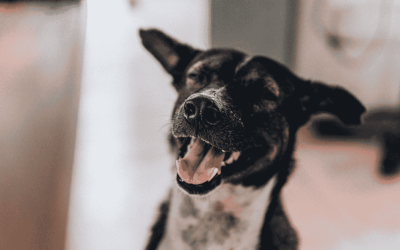As loving pet parents, we all want our cats and dogs to feel safe and secure. But animals can’t tell us when something frightens them. Instead, they communicate through body language, sounds, and subtle behaviors. Recognizing when your pet is afraid can help you prevent bites, reduce stress, and build trust through gentle reassurance. Here are 5 ways to tell when your cat or dog is scared or anxious. These ways don’t just show up during spooky season; they’re great to know if you’re heading out trick-or-treating tomorrow and every day of the year!
 1. Retreating or Hiding
1. Retreating or Hiding
One of the clearest signs of fear is when your pet tries to withdraw from a situation. A frightened dog might slink behind furniture, tuck its tail, or seek out a quiet corner. Cats are especially skilled at disappearing when stressed. They often retreat under beds or inside closets.
Avoidance behaviors like retreating or hiding help them feel more in control. If your pet retreats, don’t force closeness or try to coax them out immediately. Allow them space to calm down and reemerge when they’re ready. This is especially true if your dog or cat retreats while on a leash. Let them take you where they feel more comfortable and assess the situation once they stop pulling away from the whatever triggered their fearful or anxious response.
 2. Stiffened or Rigid Body Language
2. Stiffened or Rigid Body Language
Fear often freezes a pet before it triggers flight or fight like retreating or hiding. A stiff body with a low stance, tucked tail, flattened ears, or rigid posture indicates high tension. A stiff dog may be on edge, ready to bolt or defend itself, while a cat’s stillness can precede a sudden swat or dash for cover. When you see this, gently take the pet from the situation or remove the item that is frightening them, and allow the animal time to relax.
Stiffened body language can be very subtle, so it’s easy to miss. This video by K9 Turbo Training is a great tutorial on canine postures and what they are trying to communicate. If your cat goes stiff or rigid, it could mean discomfort, stress, or other concerns.
 3. Raised Hackles
3. Raised Hackles
When a cat or dog’s fur stands up along their back or neck, it’s known as raising their hackles. This is an involuntary response triggered by adrenaline, making the animal appear larger and more threatening to potential threats. It doesn’t necessarily mean aggression, it’s often a display of fear or overstimulation. If you notice raised fur, stay calm, give space, and/or take your pet to a safe, quiet place until their body relaxes again.
 4. Whale Eye or Darting Eyes
4. Whale Eye or Darting Eyes
The eyes are powerful indicators of stress. “Whale eye” describes the moment when an animal keeps its head turned away but you can clearly see the whites of its eyes. This sideways glance shows that the pet feels uneasy and is watching for possible escape routes.
Similarly. rapid, darting eye movements can signal that a pet feels cornered or threatened. When you see this expression, speak softly, lower your body posture, and remove any triggers from the immediate environment. For cats, wide eyes can signal a number of sentiments, as described in this video.
 5. Growling, Hissing, or Other Defensive Sounds
5. Growling, Hissing, or Other Defensive Sounds
Vocal warnings are another common way pets express discomfort. Dogs may growl or bark sharply, while cats might hiss, yowl, or growl when scared. These are not acts of defiance, they’re requests for distance. Punishing vocalizations can make fear worse and damage trust. Instead, honor these warnings as communication that your pet feels unsafe, and work on creating a calmer situation.
Punishing growls and hisses is dangerous because an animal that doesn’t have the ability to warn you with a growl or hiss has to go straight to a bite or scratch. We want growls or hisses because they are their way of telling us, “I don’t like that.” before their fear escalates.
Responding with Compassion
When our pets show these and other fear signals, our response should always come from empathy. Avoid forcing interaction or scolding fearful behavior. Instead, reward calmness, maintain predictable routines, and provide safe spaces, especially during chaotic times like holidays, moves, and other adjustment periods.
Over time, patient and understanding responses will help your pet gain confidence, knowing you’re someone they can trust no matter what scares them or when.
5 Ways to Tell if Your Cat or Dog Is Scared
At Hearts at Home Pet Sitting, our team is trained to observe cat and dog body language to ensure that they are at ease during our interactions. Whether we’ve known them for a few days or a few years, our observations are the same because we change and so do our pets. What they may have ignored yesterday could set them off today.
That said, if you know that your cat or dog has an ongoing fear of something or experiences anxiety during weather or noisy events, please let us know. When we are armed with that information, we can better serve them and you.
The Best Dog Walkers & Pet Sitters in Yorktown, Poquoson & Neighboring Communities
Hearts at Home Pet Sitting has been providing trusted, professional dog walking, dog sitting, and cat sitting in the Yorktown, Poquoson, Newport News, and Hampton, Virginia areas since 2012. To register your pet(s) or home with us, please complete a new client questionnaire here. Existing clients may request services here.
Please visit our website or contact us by email at Hello@HeartsAtHomePetSitting.com or by phone at 757-745-9868 to learn more.
Those outside our service area are encouraged to find a pet sitter near you at the Pet Sitters International or National Association of Professional Pet Sitters websites.




0 Comments